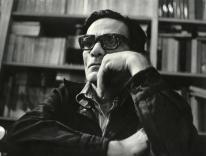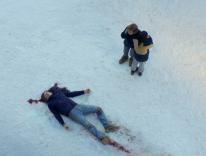Ambiguity in drama and literature has had good press throughout the last century, and rightly so. If a novel, play, or movie is to reflect the depth and multifariousness of life, it’s bound to introduce uncertainties into plot and characterizations. But there is ambiguity and then there is ambiguity. There is the sort that points toward the underlying mysteries of existence, and there is the kind that results from the writer withholding basic information. The first is what we find in the fiction of Dostoyevsky and Kafka, Beckett’s plays, Bergman’s movies; the second belongs to detective fiction or such trick-ending stories as “The Lady or the Tiger,” which are designed “to make you think,” as eighth-grade teachers tell their classes when assigning them as homework.
John Patrick Shanley surely intended Doubt, both his play and the film he’s made of it, to achieve the depth belonging to the former group. But it winds up in the latter, except that its conclusion denies you the satisfaction of the detective’s solution. Set in New York City in 1964, the story presents us with these antagonists: Sr. Aloysius Beauvier, a parochial school principal who casts a jaundiced eye on humanity and keeps her squirmy kids in line with well-aimed dope slaps, sarcasm, and extra homework. Positioned against her is the new parish priest, Fr. Brendan Flynn, who preaches the gospel of love and is obviously receptive to the aims of Vatican II (though that movement isn’t actually mentioned in the movie). Sr. Aloysius, regarding hierarchy and rigid order as lifeboats for floundering souls, would like the newfangled Flynn gone and finds the means of banishing him when a teacher, Sr. James, reports the suspicious circumstances of an interview the priest had with the only black child in the school. A pedophile’s advances? Or just kindly concern for a kid who may feel isolated? Absolutely convinced that it’s the former, Sr. Aloysius swoops, battle is joined, the hard facts remain unproved while a skillfully timed lie by one of the combatants defeats the other, but even that victory is rendered temporary by the final fade-out.
If you have been told that this drama unfolds as the clash of two equally complex characters, forget it. You won’t be able to make up your mind about the priest, but that is simply because Shanley withholds decisive information about him, not because of richly layered characterization. What transpired in the rectory remains unseen and unknown, just as the murder in a detective story remains unseen (though not, finally, unknown). Sr. Aloysius’s sleuthing ferrets out clues that point to Flynn’s guilt but then encounters explanations that indicate his innocence. The movie aims to instill doubt in the viewer and succeeds in doing so. But is Doubt’s doubt a truly disturbing emotion communicated by a probing work of art, or is it just the uncertainty we have to feel whenever we don’t have the facts of a case?
Suppose the rectory incident had been shown, and in such a way that we could detect that the priest was homoerotically drawn to the twelve-year-old but was also determined to suppress his urges while offering the boy platonic friendship and much-needed psychological counseling. The sexual desire persists, however, as does Sr. Aloysius’s investigation. Wouldn’t she be right to stay concerned for the boy’s safety? Certainly. But wouldn’t Fr. Flynn be noble (at least in intention) in wanting to help the boy even if contact with him exacerbates the priest’s tendencies? Certainly. In this case you would have ambiguity of psychology, motive, and ethics, and not the mere ambiguity of the did he or didn’t he? typical of a tidy detective novel. (I’m not suggesting that this is the only way Shanley had to develop his story; I’m just asking for more complexity.)
To be fair, Doubt is Sr. Aloysius’s journey, not Flynn’s, a journey into doubt, moving from confident, even bigoted knowingness into a troubled mental limbo by the end. Within Shanley’s dramatic scheme it is her complexity that matters, not the priest’s. And the writer-director does strive for some complication here, introducing the nun as a hard-boiled near-cynic but gradually revealing her real concern for the boy’s innocence, and her justified resentment of the way parish nuns are held subordinate to (relatively) well-living priests. He also has Aloysius display an unexpectedly rich vocabulary (“the wind is so peripatetic this year”) and the revelation that she was once married.
I cannot see, however, where these psychological grace notes mesh with the central action of the plot. Does it really matter to the story that Aloysius has known married life if we never discover what her husband and his death specifically meant to her? And her final doubt doesn’t really grow organically out of her previous actions. It’s caused by a lie she feels compelled to tell in order to bring about justice. As she herself states early in the drama, “In the pursuit of wrongdoing, one steps away from God,” but, she adds, one steps back to him when wrongdoing is conquered. So, since she never comes to doubt Flynn’s guilt, why the final doubt about her lie? Why doesn’t she feel that she has stepped back to God? I’m not asking Shanley to make his character inhumanly consistent but to delve into her very human inconsistency.
Within the limits of the script, Doubt is well executed. Aided by a superb cinematographer, Roger Deakins (whose name seems to turn up in the credits of every major studio release), Shanley renders the look of early ’60s parish life with savvy. You can practically sniff the odor of fried food in the convent hallways and the incense burned at Mass. And, though he manufactures a few bits of corny symbolism (the Winds of Change actually blow through the convent garden), the use of composition and gesture are astonishingly confident, considering that this is Shanley’s second film-directing job. Look at the way Sisters Aloysius and James seem to close in on Flynn when they first question him in the principal’s office about his relations with the boy. Because the nuns are seated while Flynn moves about, this suggestion of a tightening noose is brought about by clever camera placement and editing.
Above all, Doubt is a cornucopia of acting opportunities, and the cast doesn’t hang back from the feast. I thought Meryl Streep italicized Aloysius’s initial unpleasantness to the verge of caricature, but in the later scenes the actress’s careful blend of tremulousness and implacability in the face of Flynn’s wrath helps make the climactic confrontations exciting. Still, this is one of Streep’s more effortful performances; it’s the rest of the cast that dazzles.
When it comes to ambiguity, no actor is better than Philip Seymour Hoffman. He conveys Flynn’s possible creepiness and possible saintliness not just by turns but simultaneously in a portrait that is downright cubistic. As Sr. James, Amy Adams shows how heartbreakingly vulnerable a youthful idealist can be, and Viola Davis deserves the kudos she has won as the boy’s mother: though given only one scene, she so fully inhabits the character that you can read the woman’s life in the actress’s eyes.
Doubt may very well provoke lively discussion on the ride home from the theater, but will it disturb your dreams? That’s the difference between ambiguity employed as showy cleverness and ambiguity used in the service of major drama.
Related: Grant Gallicho reviews Doubt on Broadway
Please email comments to [email protected] and join the conversation on our Facebook page.
Previous Story
After Enlightenment
Next Story
Worth a Read: Chris Currie on Cooperation in the Prolife Movement


